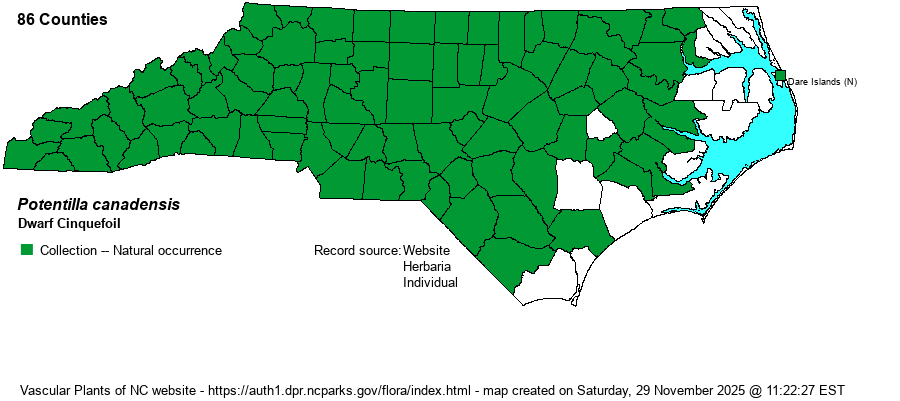| Author | L. | |
| Distribution | Essentially statewide, though apparently absent from most eastern counties.
This is an Eastern species, ranging from eastern Canada south to central GA and AR.
| |
| Abundance | Common to very common across the state, except rare to uncommon in the eastern Coastal Plain, and even locally absent in some far eastern counties there. | |
| Habitat | This is a native species that appears rather weedy, almost like an exotic plant. It grows mostly in clearings, roadsides, wooded borders, fields, lawns, and openings in upland woods. It clearly favors dry soil as opposed to moist soil. | |
| Phenology | Blooms from March to May, and fruits from April to May. | |
| Identification | This is a very familiar "weed" of open places with relatively little competition. It is low-growing, leaning to eventually prostrate, and barely to 4-5 inches long. It has basal and stem leaves that are 5-parted, with each leaflet wedge-shaped or fan-shaped, about 1 inch long and almost half as wide near the tip (but the two outer leaflets are shorter). In this species, the leaflets are untoothed along the lower half, and essentially straight, whereas in the similar and also native P. simplex each leaflet is elliptical to narrowly oblanceolate, about 2 inches long but only about 1/3 as wide, and the entire margin is toothed. The latter plant is also a larger or at least longer plant, and it can grow to 1-2 feet long or more. Each species has a single bright yellow flower, with 5 rounded petals (often notched at the apex), from a leaf node, and a spread flower about 1 inch across. There are some differences between the two about flowering nodes -- P. canadensis has its first flower from the lowest node, whereas P. simplex has its lowest flower from the second node. Nonetheless, you should be able to separate these two easily just by the shape of the leaflet -- short and wedge-shaped in this one (and entire along the lower half) versus long and more finger-like and entirely toothed in P. simplex. There are numerous exotic species of Potentilla in the state, but they are more robust or more upright. | |
| Taxonomic Comments | Many references list subspecies or varieties, but Weakley (2018) does not.
| |
| Other Common Name(s) | Running Rive-fingers, Running Cinquefoil | |
| State Rank | S5 | |
| Global Rank | G5 | |
| State Status | | |
| US Status | | |
| USACE-agcp | | |
| USACE-emp | | |

